
Egg salad is a dish consisting of chopped hard-boiled or scrambled eggs, mustard, and mayonnaise, and vegetables often including other ingredients such as celery.

Liverwurst, leberwurst, or liver sausage is a kind of sausage made from liver. It is eaten throughout Europe, as well as North and South America, notably in Argentina and Chile.
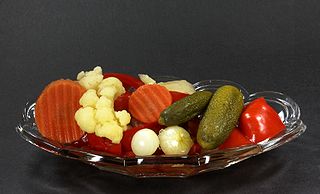
Mixed pickles are pickles made from a variety of vegetables mixed in the same pickling process. Mixed pickles are eaten much like other pickles: in small amounts to add flavor and to accent a meal. Mixed pickles appear in many different world cuisines.

Kraft Foods Group, Inc. was an American food manufacturing and processing conglomerate, split from Kraft Foods Inc. on October 1, 2012, and was headquartered in Chicago, Illinois. It became part of Kraft Heinz on July 2, 2015.

A relish is a cooked and pickled culinary dish made of chopped vegetables, fruits or herbs and is a food item typically used as a condiment to enhance a staple. Examples are chutneys and the North American relish, a pickled cucumber jam eaten with hot dogs. In North America, the word "relish" is frequently used to describe a single variety of finely chopped pickled cucumber relish, such as pickle, dill and sweet relishes.

Vlasic is an American brand of pickles that is currently owned by Conagra Brands. Since its introduction in 1942, it has become one of the most popular pickle brands in the United States.

A Chicago-style hot dog, Chicago Dog, or Chicago Red Hot is an all-beef frankfurter on a poppy seed bun, originating from the city of Chicago, Illinois. The hot dog is topped with yellow mustard, chopped white onions, bright green sweet pickle relish, a dill pickle spear, tomato slices or wedges, pickled sport peppers, and a dash of celery salt. The complete assembly of a Chicago hot dog is said to be "dragged through the garden" due to the many toppings. The method for cooking the hot dog itself varies depending on the vendor's preference. Most often they are steamed, water-simmered, or less often grilled over charcoal.

Smørrebrød, smørbrød "butter bread" (Norwegian), or smörgås "butter goose" (Swedish), is a traditional open-faced sandwich in the cuisines of Denmark, Norway and Sweden that usually consists of a piece of buttered rye bread, topped with commercial or homemade cold cuts, pieces of meat or fish, cheese or spreads, and garnishes.
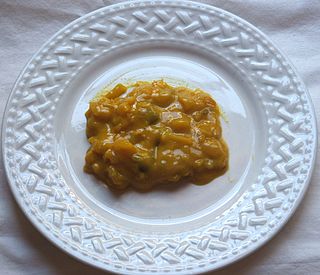
Chow-chow is a pickled dish from the American South.

Branston is an English food brand best known for the original Branston Pickle, a sweet pickle first made in 1922 in the village of Branston near Burton upon Trent, Staffordshire, by Crosse & Blackwell. The Branston factory proved to be uneconomical, and production was moved to Crosse & Blackwell subsidiary, E Lazenby & Sons in Bermondsey, London, where it invested in new buildings in 1924 and 1926, which remained in use until 1969.

A pickled pepper is a Capsicum pepper preserved by pickling, which usually involves submersion in a brine of vinegar and salted water with herbs and spices, often including peppercorns, coriander, dill, and bay leaf.

Fried pickles are a side dish and appetizer found commonly in the Southern U.S. They are made by deep-frying sliced battered dill pickles.

Corn relish is a traditional Southern United States recipe for cooked whole corn kernels, spiced with red and green bell peppers, peppercorns, and equal parts sugar and cider vinegar.
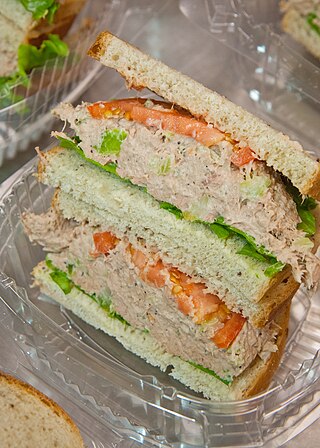
A tuna fish sandwich, known outside the United States as a tuna salad sandwich or a tuna sandwich, is a sandwich made from canned tuna—usually made into a tuna salad by adding mayonnaise, and sometimes other ingredients such as celery or onion—as well as other common fruits and vegetables used to flavour sandwiches. It is commonly served on sliced bread.
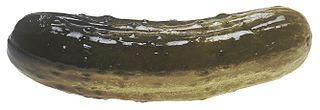
A pickled cucumber – commonly known as a pickle in the United States and Canada and a gherkin in Britain, Ireland, South Africa, Australia, and New Zealand – is a usually small or miniature cucumber that has been pickled in a brine, vinegar, or other solution and left to ferment. The fermentation process is executed either by immersing the cucumbers in an acidic solution or through souring by lacto-fermentation. Pickled cucumbers are often part of mixed pickles.
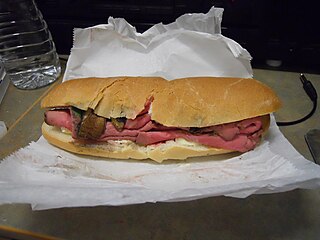
The roast beef sandwich is a sandwich that is made out of sliced roast beef or sometimes beef loaf. It is sold at many diners in the United States, as well as fast food chains, such as Arby's, Rax Roast Beef, and Roy Rogers Restaurants. This style of sandwich often comes on a hamburger bun and may be topped with barbecue sauce and/or melted American cheese. The roast beef sandwich also commonly comprises bread, cold roast beef, lettuce, tomatoes, and mustard, although it would not be uncommon to find cheese, horseradish, fresh/powdered chili pepper and even in some cases red onion. Roast beef sandwiches may be served hot or cold, and are sometimes served open faced.

Heinz Sandwich Spread is a blend of salad cream and relish manufactured by Heinz and popular in the Netherlands and Britain. It is classified by the manufacturer as a sauce or relish. The relish ingredients are spirit vinegar, sugar, cabbage, rapeseed oil, water, carrots, gherkins, modified cornflour, salt, onions, egg yolks, red peppers, mustard, stabilisers: guar gum and xanthan gum, spice extracts, spices, herb extract, flavourings and colour: riboflavin; vegetables 35%. The salad cream base results in a more tart flavour than similar mayonnaise-based sandwich spreads found in the United States.

Olivier salad is a traditional salad dish of Russian cuisine. Its creation is generally attributed to Lucien Olivier.

Pastrami on rye is a sandwich comprising sliced pastrami on rye bread, often served with mustard and Kosher dill pickles. It was popularized in the Jewish delicatessens of New York City and has been described as New York's "signature sandwich". It was created in 1888 by the Lithuanian immigrant Sussman Volk, who served it at his deli on Delancey Street in Manhattan.




















